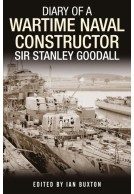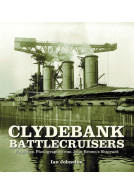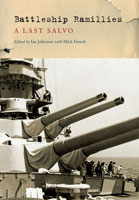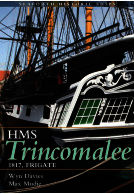The Battleship Builders (ePub)
Constructing and Arming British Capital Ships

File Size: 29.0 MB (.epub)
Pages: 320
Illustrations: 280 b/w photos and line drawings
ISBN: 9781473822269
Published: 11th February 2014
| Other formats available | Price |
|---|---|
| The Battleship Builders Paperback Add to Basket | £19.99 |
| The Battleship Builders Hardback Add to Basket | £30.00 |
The launch in 1906 of HMS Dreadnought, the worlds first all-big-gun battleship, rendered all existing battle fleets obsolete, but at the same time it wiped out the Royal Navy's numerical advantage, so expensively maintained for decades. Already locked in an arms race with Germany, Britain urgently needed to build an entirely new battle fleet of these larger, more complex and more costly vessels. In this she succeeded spectacularly: in little over a decade fifty such ships were completed, almost exactly double what Germany achieved. It was only made possible by the country's vast industrial nexus of shipbuilders, engine manufacturers, armament firms and specialist armour producers, whose contribution to the creation of the Grand Fleet is too often ignored. This heroic achievement, and how it was done, is the central theme of this book.
It charts the rise of the large industrial conglomerates that were key to this success, looks at their reaction to fast-moving technical changes, and analyses the politics of funding this vast national effort, both before and during the Great War. It also attempts to assess the true cost and value of the Grand Fleet in terms of the resources consumed. And finally, it describes the effects of the post-war recession, industrial contraction, and the very different conditions that influenced the last generation of British battleships built before and during the Second World War.
This is a revised paperback edition of the bestselling book first published to great critical acclaim in 2013.
A work of absolute first magnitude that, as such, can not be missed in the library of any lover of navy history.
STORIA militare, January 2018
I am writing this review less than 24 hours after opening this book. It is a gem! I admit to so far reading only 5 of the 13 chapters, and those almost at random, in preference to a night’s sleep, and I am greatly anticipating devouring the remainder.
Dr John Viggers, Freelance
The subject is the making of battleships 1863-1945. 320 pages, triple columns, and a cornucopia of photographs, tables, plans, diagrams and maps.
I like history, engineering awes me, and I appreciate thoroughness and detail. This book has it all.
Despite the mass of detail, the writing style is clear and articulate and easy to read.
At this time I have read the chapters on armament, armour, money, and the introduction and conclusions. I will soon go back to the powering, the facilities, the building, etc. I was wondering just how they did make, shape, and attach steel armour up to 12 inches thick to the sides of ships*. And how did they make those huge guns? It is all there, including detailed descriptions and photographs of the manufacturing processes, the factories, the work forces, the costs, the materials, the physical handling of the huge pieces, the testing. And the corruption, and the cost to the national economy.
A fascinating story. Absolutely, thoroughly recommended.
*spoiler alert! The armour plates were bolted from the inside, into threaded holes, using bolts 3-4 inches diameter. The holes were made and threaded before the plates were hardened. The plates had tongue and groove edges.
As featured on War History Online
War History Online, Mark Barnes
As featured in
Newcastle Journal
Using a mixture of sources for the records needed, the authors have assembled a fact filled book on a period when Britain did have the greatest ship building capability in the world...
Military Modelling - Robin Buckland
... Packed with tables of data, information on costs and profits which made many businessmen rich it also holds a fascinating collection of archive photos which show ships being built and some being dismantled for scrap. Very much an industrial history, not the service history of the ships, this presents an interesting and a look at a different aspect of a time now consigned very much to the history books.
I found information that was both new to me and interesting on nearly every page and this must be considered the definitive book on the design and construction of these iconic vessels and the industries that created them.
Australian Naval Institute
The authors must be congratulated for locating the surviving archives together with the fascinating collection of images.
The book presents a wealth of detail, facts and statistics with many tables and over forty pages of appendix. It is illustrated throughout with over two hundred black and white photographs and I was pleased to see illustrations from explosion Museum at Priddy's Hard, now part of the National Museum of the Royal Navy. This book covers a much neglected aspect of our great naval heritage and is well recommended.
Scuttlebutt - Friends of the RN Museum
No praise is too high for this book. It has been put together with considerable love and attention to detail by its two authors , and will undoubtedly become the standard reference book on the subject. It is also a fitting tribute to the many men, skilled, semi-skilled and unskilled, that worked on these magnificent ships.
Warship Annual 2014
This scholarly book contains chapters on individual firms, construction facilities, powering, armaments, armour and plate. The book itself is richly illustrated, well-produced and will be of interest to academic and lay readers alike and is highly recommended.
International Journal of Maritime History
“Technical descriptions in the book are fascinating as is the discussion and explanation of the commercial development of the supporting industries.”
World Ship Society’s “Marine News”, Richard Osborne
“Superbly written text is supported by numerous black and white photographs, plans… and pieces of equipment.”
“Truly of international importance and the authors deserve to receive high accolades from their academic peers and the wider readership as well.”
“One of the best naval titles I have seen and I doubt that a better book on the subject could be produced. The book will become a classic and is very highly recommended.”
Many, many others have wrestled with this topic but this is the only one to examine in detail the “great industrial infrastructure required to build, power, arm and protect these ships.” And by “these” ships is meant the dreadnaught class of battleship, so called after the Royal Navy’s revolutionary HMS Dreadnought of 1906 (there were five earlier ships that bore the name too) that ushered in a new era both in warfare and in manufacturing. Whether you are an economist or a strategist or a historian of engineering or industrialization, this book connects many useful dots in weighing cost vs value in standing up a Grand Fleet in the era of steam and iron (later steel). Anyone with an interest in the micro and macro effects of Big Decisions will find something of value in this supremely well-written book. Based on analyses of production and accounting records, the book paints a richly detailed picture of an enormous concerted effort by hundreds and hundreds of vendors to build the mightiest warships ever. It also points a finger at the darker side of all such undertakings: profiteering, which remained hidden from Admiralty eyes for a long time. If you’ve never given a thought to how something as monstrously complex as a battleship is built, or where the vast amounts of raw material come from, this book will give you a good idea of it.
speedreaders.info
There are a myriad of military history books churned out each year, yet very few are of true national or international importance within their field. This book is one of those exceptional publications, a book for which both authors should receive high praise from amongst their peers, the historical & academic communities and general public alike. The book is crammed full of fascinating (many unseen & unique) B/W photographs on almost every page, plus numerous maps & line drawings to help describe plant layouts or a pieces of equipment. The book is Indexed with a Bibliography and Notation pages. If you have any interest in this period of Naval history, Battleships, the Royal Navy or Naval shipbuilding , then you will do well to get hold of this book at your earliest convenience. This book will soon become a out-of-print classic that will demand large payment figures in the future. 5 stars.
www.worldnavalships.com
The Battleship Builders is a painstakingly researched historical account of sudden and enormous rise in the huge British Industrial conglomerates that built British battleships from around the beginning of the 19th century, through the sweeping changes of the Industrial revolution and it's subsequent progress into the high technology world of today.
www.navy-net.co.uk
It contains some fantastic source material from the construction of these fantastic examples of engineering and manufacturing prowess, through photographs, historic document and ship's drawings, as well as some very detailed analysis of the progress of ship building technology throughout this time.
A brilliant book for those who are keen to really get under the deckplates of these fantastic ships.
Andrew Hill
There are a myriad of military history books churned out each year, yet very few are of true national or international importance within their field. This book is one of those exceptional publications, a book for which both authors should receive high praise from amongst their peers, the historical & academic communities and general public alike.
This book charts the British industrial shipbuilding and arms manufacturing conglomerates, that helped forge & construct the 50 odd battleships that gave the Royal Navy a global presence & strength from the early years of the 20th Century, through to the eve of WW2 where it was over-taken by the industrial might of the USA and the ships of the USN. We see how these huge industrial concerns rose to the challenge posed by Germany prior to WW1, the technological advancement of production techniques, the physical expansion of facilities and the merry dance of financial priorities played by both the Admiralty & the various ship builders. After WW1, the passing of various naval treaties and the global financial depression saw many famous names disappear or merge to survive. How the Admiralty tried to keep the yards busy and skilled labour employed, whilst balancing its treaty obligations and its dwindling budget working as best it could. All these facets would have far reaching consequences when new Battleships were needed to provide a defence against a resurgent Germany and the growing menace of both Italy & Japan.
To tell this story of how Britain built more Battleships than any other nation in history, the authors have broken the book into some 13 chapters. The first 3 chapters gives us the broad historical foundations & backdrop from 1860-1945, when these momentous events took place. Chapter 4 The Builders, details out all the main ship builders yards, with detailed schematic maps of there building operations. The information is priceless, especially since many of these companies no longer exist, and their archives destroyed, lost or scattered in the wind. Chapter 5 concentrates on the actual construction & construction techniques. Chapter 6 looks at the facilities such as dry docks, cranes, covered sheds & berths etc. Chapter 7 deals with the powering requirements of Battleships, whilst Chapter 8 gets to grips with the procuring of guns for them. The other essential element of Battleships, Armour, is covered in Chapter 9. How the armour was produced from plants (mainly around Sheffield) and how the requirements changed over time and its onward effects. The vital export market in Capital ships is covered in 10. The key element of money is analysed in Chapter 11 and how the companies tried to win contracts, where they made & lost money on the contracts, which all dovetails in nicely to the subject of manpower in Chapter 12. The conclusion being the final and shortest chapter of the book. There are 3 appendices of which the third deals with the British Battleship Breaking Industry, where a lot of money was made & lost.
The book is crammed full of fascinating (many unseen & unique) B/W photographs on almost every page, plus numerous maps & line drawings to help describe plant layouts or a pieces of equipment. The book is Indexed with a Bibliography and Notation pages.
If you have any interest in this period of Naval history, Battleships, the Royal Navy or Naval shipbuilding , then you will do well to get hold of this book at your earliest convenience. This book will soon become a out-of-print classic that will demand large payment figures in the future.
5 stars
About Ian Buxton
IAN BUXTON is a naval architect who was Reader in Marine Transport at the Department of Marine Technology at the University of Newcastle-upon-Tyne from 1974-2002. The Marine Technology Special Collection and the British Shipbuilding Database of 80,000 British-built ships have been a major focus in recent years. In 2021 he was awarded an MBE for services to the preservation of British maritime history. He has written numerous articles dealing with technical shipping and shipbuilding issues.
About Ian Johnston
IAN JOHNSTON is a well-known authority on Clydeside shipbuilding and the historian of both John Brown’s and Beardmore’s. His training as a graphic designer is to be seen in the superb choice of photographs from the John Brown collection in Clydebank Battlecruisers and A Shipyard at War. This new book is a labour of love as Ian’s father worked for Thermotank, whose achievements he felt deserved wider public recognition.
























